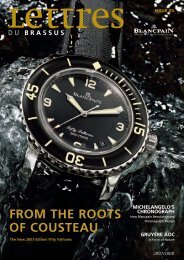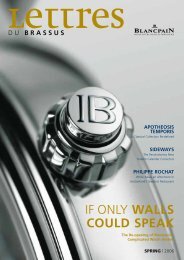THE HISTORY OF BLANCPAIN
THE HISTORY OF BLANCPAIN
THE HISTORY OF BLANCPAIN
Create successful ePaper yourself
Turn your PDF publications into a flip-book with our unique Google optimized e-Paper software.
ART DE VIVRE<br />
premier crus between 90-99 and champagne<br />
between 80-89. Thus, on the official<br />
scale, a 99 point premier cru vineyard village<br />
was well distinguished from one with merely<br />
a 91 point ranking.<br />
More than that, the rankings were done<br />
by grape. In champagne three grapes may<br />
be used, chardonnay, pinot noir or meunier<br />
and, for at least chardonnay and pinot noir,<br />
there are separate rankings of vineyards<br />
using the 100 point scale. Thus, Chouilly’s<br />
grand cru rating is for only the chardonnay<br />
list; a completely separate collection of vineyards<br />
comprises the pinot noir list. There are<br />
nine grand cru chardonnay villages, thirteen<br />
for pinot noir. Meunier, never rises above the<br />
lowest level.<br />
All Lenoble champagnes are made with<br />
either grand cru or premier cru grapes. Indeed,<br />
the lowest ranked vineyard used is<br />
Anne and Antoine Malassagne.<br />
rated at 95 points. The large houses with<br />
their vast volumes are simply incapable of<br />
adhering to that lofty a standard.<br />
No matter how riveting this heretofore<br />
seemingly state-secret list may have been,<br />
sitting in a reception room gaping at the<br />
finely calibrated rankings was still not the<br />
optimal way to come to an understanding of<br />
champagne terroir. Jumping into Antoine’s<br />
car, it was time to traverse Épernay and head<br />
to Chouilly. Lenoble’s two top cuvées, Les<br />
Aventures and Le Gentilhomme both are<br />
made exclusively from grapes grown in<br />
Chouilly. This means that both are 100%<br />
grand cru champagne and both are 100%<br />
chardonnay.<br />
First stop, one of Lenoble’s vineyards in<br />
Chouilly, Le Vallon. Le Gentilhomme is made<br />
of grapes from Le Vallon and Les Cités,<br />
another nearby parcel in Chouilly. As we<br />
walked the rows in Le Vallon a question<br />
immediately popped to mind. Since these<br />
are chardonnay grapes, the same as are<br />
used in burgundy, and planted in a grand<br />
cru parcel, what would happen, if for example,<br />
one tried to fashion champagne out of<br />
chardonnay grown in a burgundy grand cru<br />
parcel such as Corton-Charlemagne? This<br />
did not provoke a smile. Antoine, fully<br />
expressing the same fondness for this idea<br />
as he would have had eating week old fish<br />
and setting a countenance pitying the profound<br />
lack of understanding embedded in<br />
the question, explained that great champagne<br />
is dependent on layers of chalk and<br />
other minerals in the soil. They give an<br />
astringency to the wine which balances it.<br />
White burgundy grapes would be far too<br />
rich and heavy ever to be considered for a<br />
fine sparkling wine (of course it is that same







